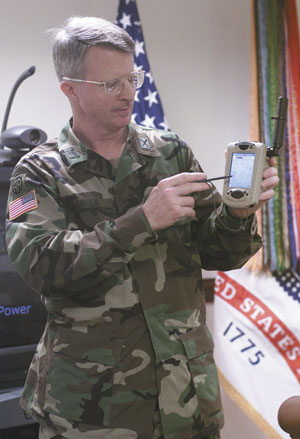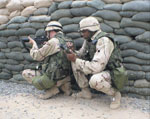Army Intelligence Digitizes Situational Awareness
 |
| Col. Richard Hansen, USA, demonstrates the Force XXI Battle Command Brigade and Below (FBCB2) commander’s digital assistant (CDA). This device brings vital situational awareness information to individuals and allows them to provide intelligence data to the FBCB2 network. |
Location and intelligence information that only recently was introduced to U.S. Army ground combat vehicles soon may find its way into the hands of the individual soldier. Army engineers working with industry partners are finding ways to move vital position-location information down past the command level. The result may be a two-way flow of intelligence between headquarters and individual soldiers on the ground.
These efforts have taken the form of a series of steps that first incorporate limited capabilities to the individual commander and then add two-way capabilities leading down the chain to the infantryman. Individual soldiers on the ground have been able to send information up the chain of command from foot patrols in urban environments. More advanced systems are allowing these same soldiers to exchange this same information with one another in densely populated and heavily built-up areas.
The Army is implementing these advances using military and commercial off-the-shelf technologies without investing any of its own research and development funding. Not only does this save money, it also allows for faster integration into the force.
“We are focused on spiraling capabilities to the field quickly that the soldier needs now, instead of using the normal acquisition process,” says Lynn Schnurr, director, intelligence community information management, Army G-2.
These capabilities are based on existing commercial and Army technologies and systems. This permits them to be fielded quickly and to be integrated seamlessly into network operations. Suddenly, soldiers are acquiring capabilities that used to be considered available only at the end of a long and complex future program.
Col. Steven G. Fox, USA, chief of the transformation division, intelligence, surveillance and reconnaissance, Army G-2, explains that the joint intelligence operation capability effort is built around the concept of every soldier is a sensor and has the best local situational awareness. By digitizing that information as close to the source as possible, that data can be entered into a single integrated database that will permit effective analysis and collaboration at all levels.
“The focus of the capability that it provides is to get better digitized information into the system for analysis,” Schnurr declares. “We don’t want filtering of data. This is key.
“In the past, we had seen filtering of data going on at different echelons,” she explains. “What we hear now is, ‘Give me all the data so I can then take that data and analyze it,’” she states.
Some commanders in
The FBCB2 CDA features an L-band transceiver, an integrated selective availability anti-spoofing module (SAASM) global positioning system (GPS) and a 512-megabyte smart card with limited map set and address book. It operates on the Windows CE operating system, can receive overlays and includes a panic button alert message capability with local destroy or remote disable functions.
The CDA can show the user’s location relative to other forces’ locations, and it quickly can communicate data such as situational awareness. Col. Fox describes it as an extension of the FBCB2 network to individuals.
Schnurr explains, “This gives you Blue Force Tracking right in the hands of the dismounted soldier. With FBCB2, you are tracking a vehicle. This [CDA] gives you the ability to track an individual.”
Later this year, the army will field a second CDA version that features a larger display screen; can use Linux, Solaris or Windows 2000 operating systems; can send and receive overlays; and has a 20-gigabyte hard drive. It will offer the full FBCB2 message set instead of the limited one available on the first CDA. Both of these CDAs employ many standard commercial capabilities.
The CDAs have received good reviews from the users in the field, Schnurr relates. However, they also pointed up the need for enhancements. One drawback is that a CDA user in an urban environment might not know that another is standing right around the corner. The signal from that CDA could be blocked from the other unit by a building, and neither compatriot would know of the other’s existence unless each transmitted a signal back to the FBCB2 system and received corresponding data pinpointing their locations. In addition, this roundabout process would not take place in real time.
“The teams that were using it needed to make sure that whatever they sent out, they had a reasonable assurance that it made it,” Col. Fox says. “Unfortunately, because you are in an urban environment and are line-of-sight to a satellite that is in the southern sky, buildings will block that communication. Users had to make sure that they were in the clear before they pushed the send button.
“That was primarily the main disadvantage—that message completion wasn’t as solid as we would have hoped for,” the colonel concludes.
New technologies could take advantage of available and emerging communications to provide even better capabilities for soldiers and commanders alike. The Army is working to implement those capabilities as quickly as possible.
“We wanted to bring in video and better mapping capability,” Schnurr relates. “We also wanted to make sure that it is still easy for the soldier to use because that is critical.”
So, Army intelligence officials are implementing improvements for the next fielding. These are taking the form of handheld personal digital assistants (PDAs), with the first device drawn from the INTER-4 Tacticomp 1.5.
This 2-pound system features a 400-megahertz Intel XScale processor, a 12-channel GPS receiver with active antenna, a 3.5-inch color liquid crystal display screen and up to 128 megabytes of synchronous dynamic random access memory (SDRAM).
Unlike the CDA, the Tacticomp 1.5 does not have an L-band antenna. To keep the unit as small and as lightweight as possible, planners opted to provide L-band connectivity through vehicle-mounted systems to which the handheld unit is networked. The Tacticomp 1.5 has that connectivity through its local links to the vehicle-mounted FBCB2 unit.
It also has the data port input that the CDA lacks. This permits adding other devices and plug-and-play capabilities as technologies warrant.
But the key difference between this unit and the CDA is its low-probability-of-intercept spread-spectrum mesh-network transceiver.
The mesh network opens up a host of connectivity capabilities hitherto unavailable to foot soldiers. Not only can they link with individuals carrying identical handsets, but also soldiers on patrol in urban environments no longer are limited to line-of-sight connectivity or plagued by heavy communications traffic.
This system uses the ITT military mesh network that was developed in part by the Defense Advanced Research Projects Agency (DARPA). It permits higher density coverage that far exceeds the capacity of 802.11 wireless connectivity, Col. Fox reports.
 |
| Two U.S. Army soldiers use an FBCB2 CDA in operations. The positive reviews that the system has received in Iraq are spurring the Army to accelerate more advanced personal digital assistants that will allow individuals to communicate information directly to each other from building to building. |
And, the mesh network offers another key advantage lacking in the CDA and in other FBCB2 systems. Soldiers at last will be able to link around the corner with another like user. Previously, users could not connect with a nearby compatriot without tying into a larger network via satellite. This mesh network allows a user to link directly with a fellow soldier out of sight but in the immediate vicinity—and in real time.
Information that is reported to mesh network users also is reported to FBCB2 because data go out in joint verifiable message format (JVMF). So, these unclassified messages can be input into the classified information network.
The Army fielded a handful of these handheld units in
The next step up is the Tacticomp 6, which is larger than the 1.5. It is designed to be mounted in a vehicle, but a commander can take it out on foot. Col. Fox offers that it is envisioned for use by tactical HUMINT teams that are associated with a vehicle.
This machine features an Intel 1.8-gigahertz Pentium M processor, an 8.4-inch color liquid crystal display screen and up to 1 gigabyte SDRAM. It runs Windows 2000, Windows XP, Linux or Solaris operating systems, and it includes several device and communications slots. It offers a removable 40-gigabyte rugged hard drive and is voice-over-Internet-protocol enabled. And, as does the Tacticomp 1.5, it includes an ad hoc, self-healing mesh network.
Plans call for fielding approximately 500 PDAs, 80 percent of which would be the handheld Tacticomp 1.5 units, by September. Ultimately, these PDAs could be fielded as far down the chain of command as battalion and below. As technology and requirements progress, the devices can be adapted to incorporate many different capabilities and applications.
Several capability enhancements already are in the pipeline. A handheld controller features four function buttons that duplicate the Tacticomp’s standard controls, and it includes a four-way analog joystick with an integrated Enter button. It also has a Warfighter Down button that enables a soldier to send an alarm for help immediately.
A helmet-mounted display known as the Tactisight features both a high-dynamic-range conventional metal oxide semiconductor (CMOS) camera for bright or dark conditions along with a liquid crystal display screen. The display shows aerial photographs and topographic maps, and it adjusts for day or night. It can display distance and geolocation information for all members of the user’s squad.
A future capability is the BioCam system that both transmits and displays imagery of people and their biometric data. This system reflects the increased importance of HUMINT in Army operations. Patrols in
The BioCam capability would be added to the PDA in a plug-and-play configuration. DARPA has been assisting the Army with development of the capability and technology, and the G-2 has requested funding with an eye toward fielding it in summer 2006. Future system advances may permit the PDA to capture a facial image and determine its identity locally without having to tie into exterior time-consuming networks.
Col. Fox offers that the new PDAs still could use some improvement. One need is for Type 1 encryption. Implementing this capability, which the colonel hopes will take place soon, will allow running the right types of classified information over the systems. Until this encryption is enabled, the system will continue to run unclassified applications and data.
Because the system’s level is unclassified, it cannot display data on enemy forces that usually is classified. Situational awareness data usually is unclassified, so that type of data on enemy forces—such as a message saying, “I’m taking fire”—can be displayed on the current versions.
Another capability that is on the users’ wish list is a better mapping capability. This could be complementary to another user request: the ability to store imagery.
“We’re looking at it from an information dissemination methodology [perspective], but the soldiers are looking at it from ‘we’d also like to know where our buddies are,’” Col. Fox relates, adding, “They’re going to get both in one device.”
While all of these iterations are focused on intelligence aspects of field operations, planners are working with Army officials on other efforts. Col. Fox notes that the G-2 is working with the Land Warrior program manager for the development of the Soldier Ensemble, which will provide guidance for the Army at large. And, the G-2 is working with the office of the Army G-6, Lt. Gen. Steven W. Boutelle,
Web Resources
Army G-2 Office: www.dami.army.pentagon.mil
FBCB2 Project Manager: http://peoc3t.monmouth.army.mil/FBCB2/FBCB2.html
Army Program Executive Office Soldier Programs (to lead to Commander’s Digital Assistant): www.peosoldier.army.mil/index.php?section=programs
INTER-4 (is now wholly owned by Sierra Nevada Corporation): www.sncorp.com




Comments